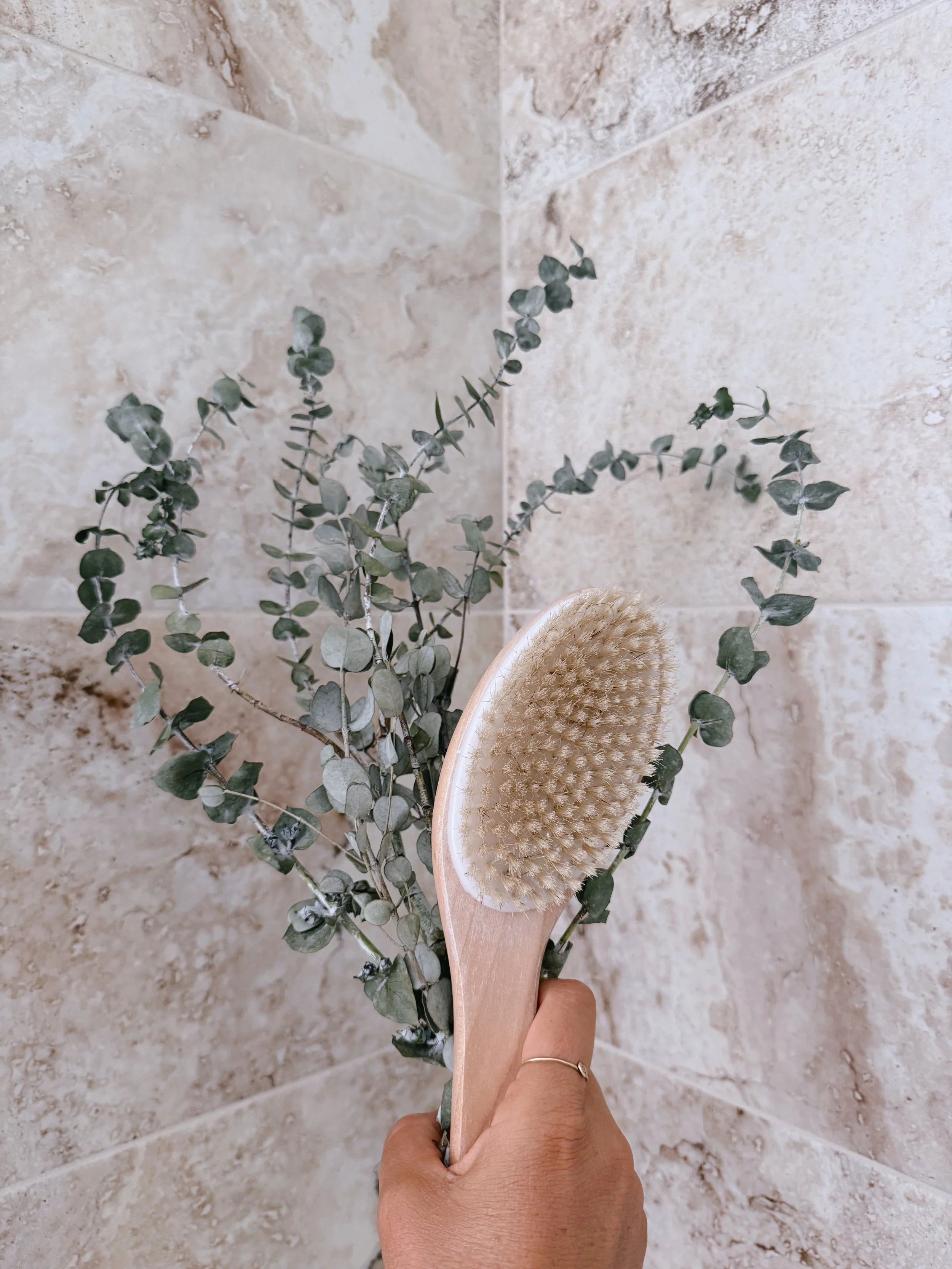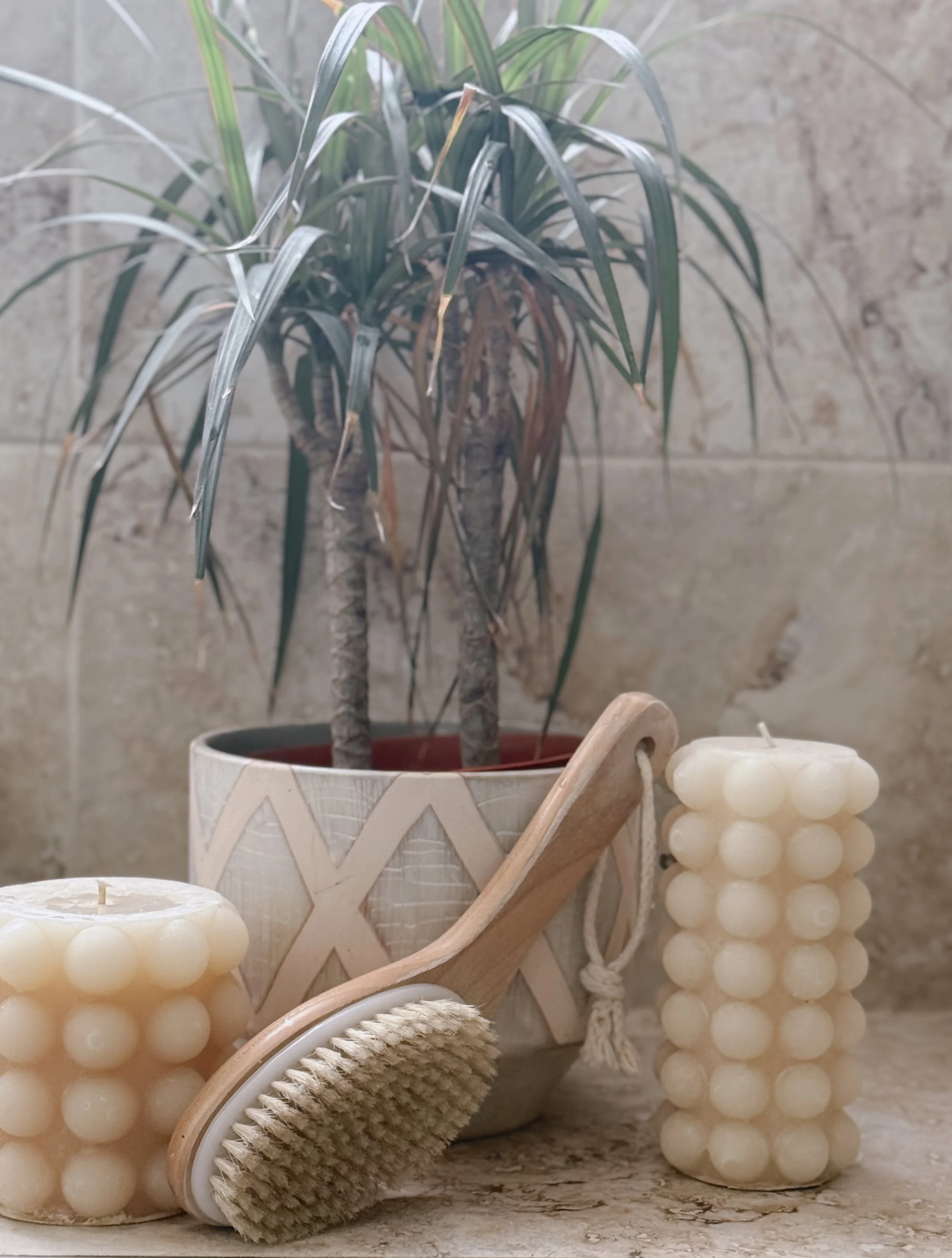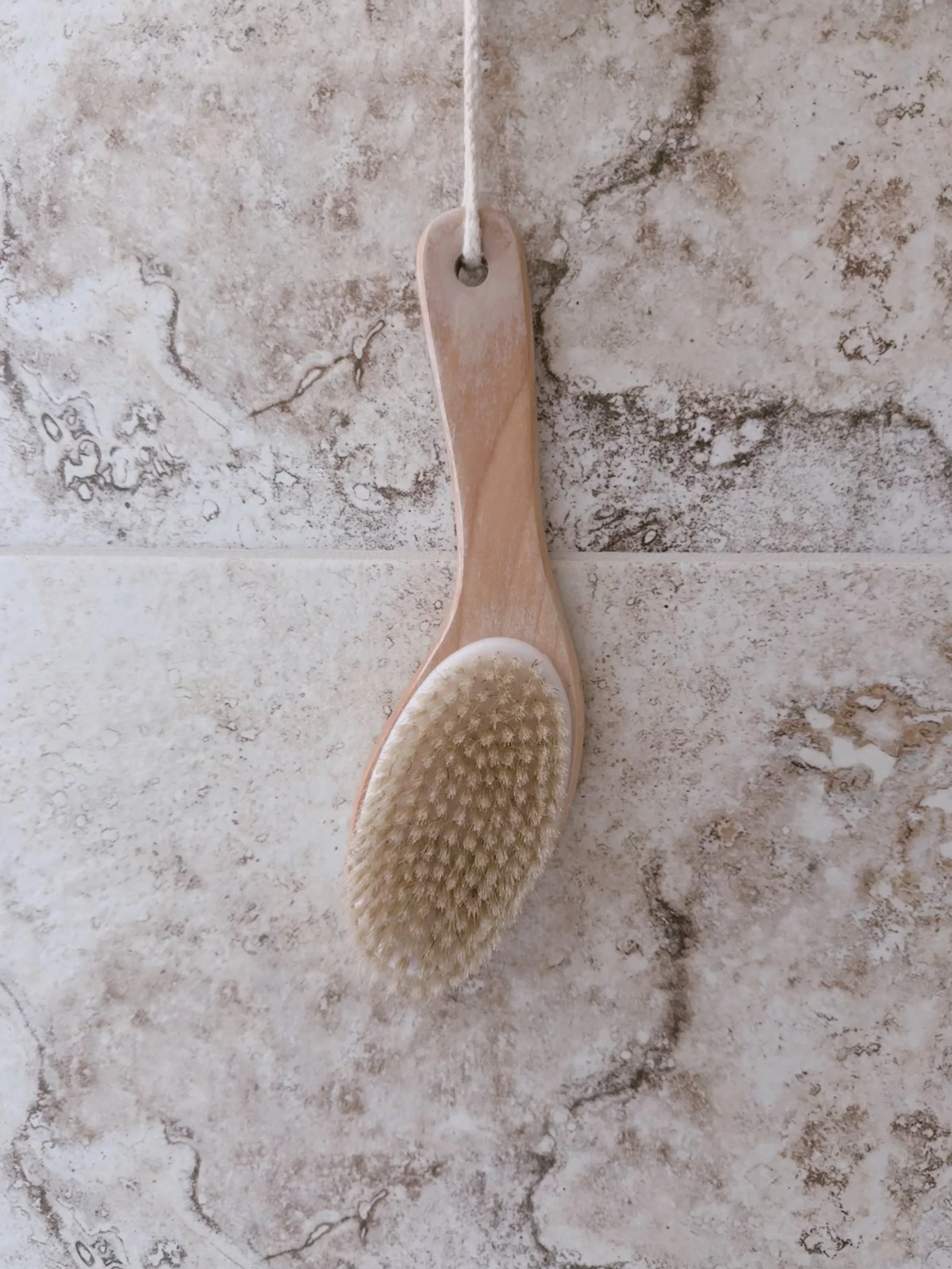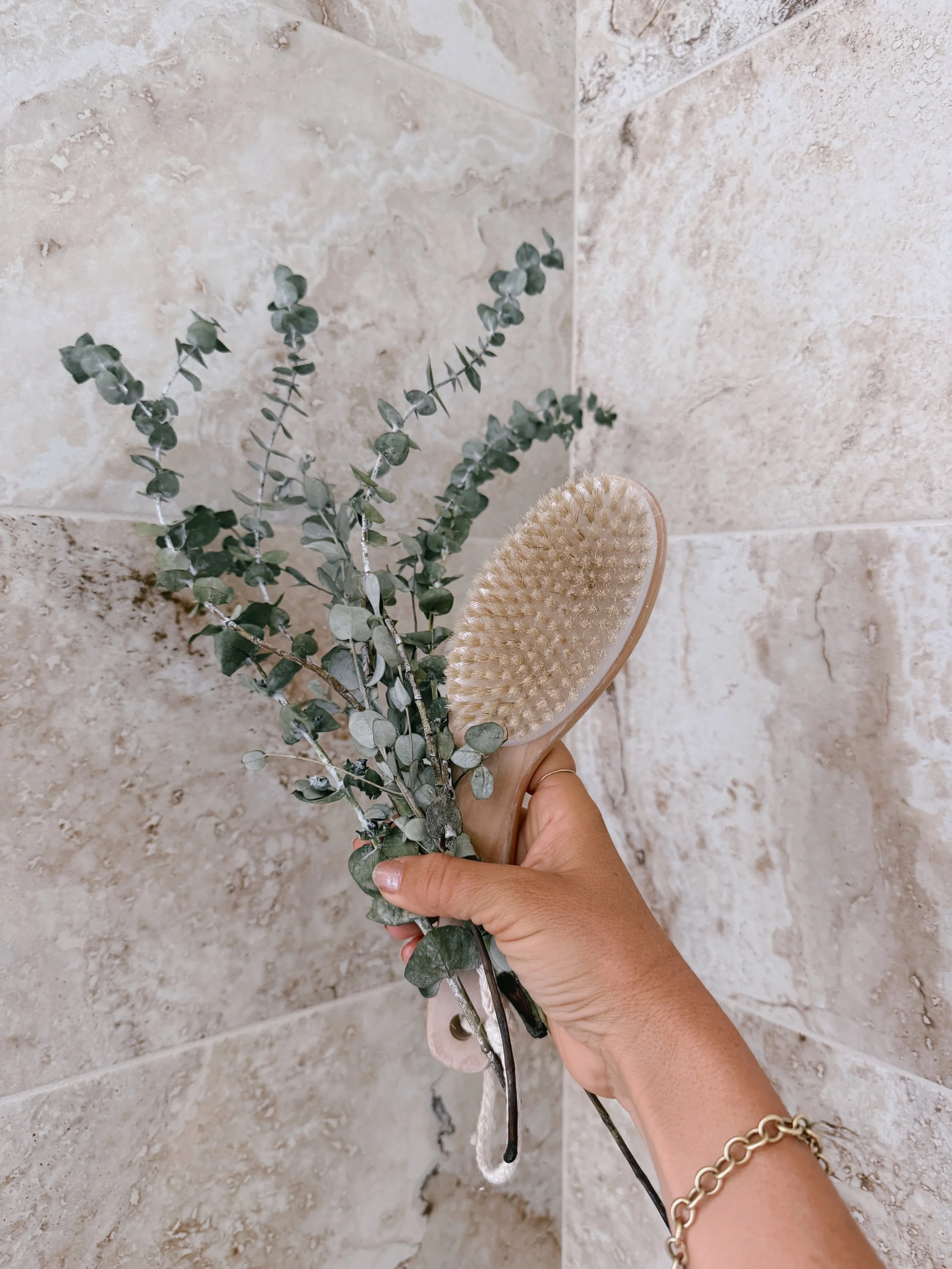Awaken Your Body: The Benefits of Dry Brushing and How to Do It
By: Courtney G. Clifford
I’m all about simple, accessible ways to nurture health and wellness—at home or on the go. And few rituals are as straightforward yet impactful as dry brushing. This ancient practice has become a staple in my morning routine. Before a shower, I take a few minutes to brush my skin with natural bristles, invigorating not only my skin but my whole body and mind. I finish with a blend of coconut oil and a few drops of essential oil—eucalyptus or lavender are my favorites—and it feels like I’ve had a mini spa session, even on the busiest day.
Dry brushing is about more than just glowing skin. It’s a grounding ritual, a gentle form of self-massage, and a potential booster for your lymphatic system and circulation. But what exactly are the benefits, and is there science to back it up? Let’s dive into the tradition, the technique, and the evidence.
What Is Dry Brushing?
Dry brushing is exactly what it sounds like: brushing your dry skin with a firm, natural-bristle brush in a specific pattern, usually before a shower or bath. The strokes are typically long and sweeping, always moving in the direction of the heart. It's quick—just 3 to 5 minutes—and can be done daily or a few times per week, depending on your skin’s sensitivity.
Dry brushing has roots in Ayurvedic medicine (where it's called garshana) and has been used for centuries across various cultures as a detoxifying and skin-stimulating ritual.
Why Dry Brushing? The Claimed Benefits
Dry brushing is most commonly touted for:
Exfoliation and smoother skin
Lymphatic stimulation
Increased circulation
Temporary reduction in the appearance of cellulite
Supporting detoxification pathways
Mental and energetic invigoration
Let’s unpack some of these claims and examine where the science stands.
1. Skin Health and Gentle Exfoliation
The most immediate benefit people notice from dry brushing is softer, smoother skin. By removing dead skin cells from the surface, dry brushing can unclog pores, support skin cell turnover, and help other topical treatments (like oils or lotions) absorb more effectively.
Unlike traditional exfoliators that may include harsh chemicals or microbeads, dry brushing offers a mechanical, non-toxic exfoliation option. According to dermatological literature, regular exfoliation—when done properly—can improve skin brightness and texture, and may support treatment of conditions like keratosis pilaris (Schulz, 2016).
That said, dry brushing is best done with gentle pressure to avoid irritation or damage to the skin barrier, especially in those with sensitive skin.
2. Lymphatic System Support
The lymphatic system is a key component of your immune and detoxification systems. It circulates lymph fluid, which helps remove toxins, waste, and other unwanted materials from the body. However, unlike the circulatory system, the lymphatic system doesn’t have a central pump. It relies on movement, breath, and muscle contraction to flow properly.
Here’s where dry brushing might help. Because the brushing strokes are directed toward the heart and lymph nodes, it’s thought to stimulate lymph flow, promoting drainage and supporting immune function.
Though clinical studies on dry brushing specifically are limited, manual lymphatic drainage (a gentle massage technique used in lymphedema therapy) has shown benefits in enhancing lymphatic flow and reducing fluid retention (Tassenoy et al., 2011). Dry brushing is not identical to lymphatic massage, but many holistic practitioners suggest it mimics some of the same directional and circulatory effects.
3. Circulation and Invigoration
Anyone who’s tried dry brushing knows the immediate feeling: warm, tingly skin and a sense of energized alertness. This is likely due to increased superficial blood flow and stimulation of nerve endings near the skin.
While empirical studies on dry brushing and circulation are scarce, studies on similar mechanical stimulation methods (like skin rolling and light massage) show improved capillary circulation and skin temperature (Wilke et al., 2018). These effects may be short-term, but they contribute to that refreshing “wake up” sensation so many people love in the morning.
4. Supporting Detoxification and Cellulite Appearance
The idea that dry brushing “detoxifies” the body often raises eyebrows in the scientific community. The liver, kidneys, and lymphatic system do the heavy lifting in detoxification. While dry brushing doesn’t detox in the way a liver enzyme does, it may support the natural elimination pathways by promoting lymphatic drainage and encouraging movement.
As for cellulite, dry brushing is not a miracle fix—but it may temporarily improve the appearance by stimulating the tissues, enhancing circulation, and reducing fluid buildup. Over time, this can lead to smoother-looking skin, though results vary.
5. A Ritual of Mind-Body Connection
Beyond the physiological benefits, dry brushing is a powerful act of self-care. It requires mindfulness, body awareness, and presence—qualities often missing in our rushed routines. The rhythmic, tactile experience of brushing can calm the nervous system, energize the mind, and even serve as a form of moving meditation.
Integrating a sensory ritual—like dry brushing followed by nourishing oils and essential oils—can create a daily moment of intention and gratitude for your body, skin, and health.
How to Dry Brush Correctly
To reap the benefits without irritating your skin, follow this simple guide.
What You Need
A natural-bristle body brush (with or without a handle)
Optional: facial brush with softer bristles
Body oil or moisturizer for aftercare (coconut oil + essential oil works beautifully)
Step-by-Step Technique
Start at your feet, using gentle, long strokes upward toward your heart.
Brush each section of the body 5–10 times, overlapping strokes slightly.
Move up the legs, then brush your abdomen in circular, clockwise motions.
Brush the arms, beginning at the hands and moving up to the shoulders.
Use lighter pressure on sensitive areas, like the chest and neck.
Avoid broken skin, wounds, or inflamed areas (like eczema or psoriasis).
Hop in the shower after brushing to rinse off dead skin cells.
Moisturize your skin while it’s still slightly damp—this locks in hydration and soothes the skin post-exfoliation.
When and How Often Should You Dry Brush?
Best time: Morning, before your shower. The invigorating effect can help wake you up and energize you for the day.
Frequency: Start with 2–3 times per week. If your skin tolerates it well, you can increase to daily.
Skin type tips:
Sensitive skin: Use a softer brush and limit frequency.
Dry skin: Follow with a rich, hydrating oil to prevent irritation.
Essential Oils and Aftercare
After dry brushing, your skin is primed to absorb moisture—and aromatherapy blends can amplify the ritual.
Here are some of my favorite pairings:
Lavender + Coconut Oil: Calming, soothing, anti-inflammatory
Eucalyptus + Jojoba Oil: Invigorating and clarifying
Rosemary + Almond Oil: Stimulating for circulation
Simply mix 1–2 drops of essential oil with a tablespoon of carrier oil and apply to your whole body.
Precautions and Who Should Avoid It
Dry brushing is generally safe for most people, but there are a few important considerations:
Avoid on broken or irritated skin, sunburns, or rashes.
Not recommended for active eczema, psoriasis flare-ups, or overly thin skin (such as in elderly individuals).
Talk to your doctor if you have a condition that affects circulation, lymph nodes, or the immune system before beginning a dry brushing routine.
Final Thoughts: A Small Ritual, A Big Return
In a world of complex wellness routines and expensive products, dry brushing stands out as a simple, affordable, and empowering practice. It takes just a few minutes, requires no chemicals or screens, and brings your awareness back to your body in a loving and invigorating way.
Whether you’re aiming for softer skin, a clearer lymphatic system, or a grounded start to your day, dry brushing is a beautiful ritual to consider. Pair it with a warm shower and your favorite body oil, and you’ve just created a sacred moment for yourself—no spa required.
References
Komori, T., Umezaki, M., & Usui, A. (2018). Effect of slow breathing with long exhalation on stress and autonomic function in healthy adults. International Journal of Behavioral Medicine, 25(4), 454–460. https://doi.org/10.1007/s12529-017-9696-4
Schulz, J. (2016). Skin physiology and its role in dermatological therapy. Journal of the German Society of Dermatology, 14(5), 426–432. https://doi.org/10.1111/ddg.12945
Tassenoy, A., De Mey, J., De Ridder, D., & Van Den Kerckhove, E. (2011). The effect of manual lymph drainage after total knee replacement surgery: A randomized controlled trial. European Journal of Physical and Rehabilitation Medicine, 47(4), 545–553.




